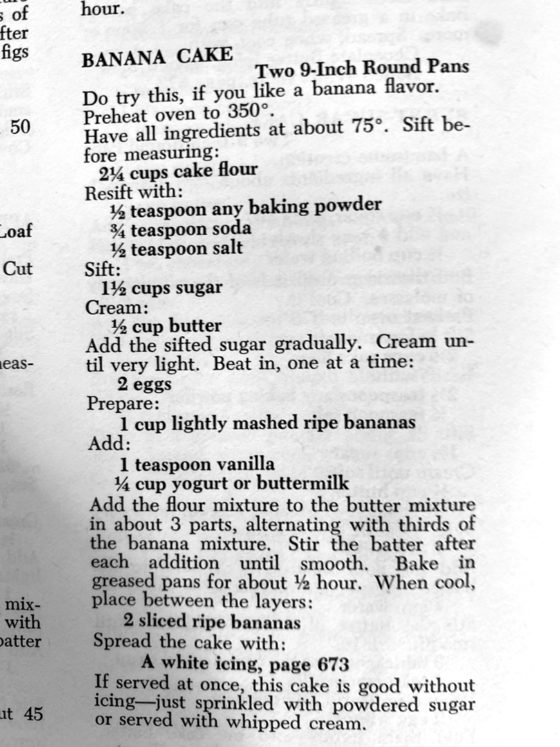
Even though there are about two weeks left of summer in New York, where the RDF office is located, we have been inundated with advertisements for pumpkin spice everything (lattes, donuts, beer, etc.) since the last week of August. Rather than turn to this fall flavor already, we thought we would share the recipe for Banana Cake from Arakawa’s painting, Untitled, 1968. Unlike your typical banana bread recipe, which is full of spice, this cake heroes the banana, and topped with pillowy layers of whipped cream, it sounded like a perfect dessert to celebrate the end of summer. While Arakawa most likely did not intend for the recipe to be baked, this painting offers a set of instructions that you can follow, as many of his other paintings explicitly ask you to do. It is always an interesting experiment to see the divergent outcomes when different people follow the same set of instructions.

This recipe comes from the 1963 edition of The Joy of Cooking, which Madeline and Arakawa most likely had on their shelves and was often the first place you might look when searching for a recipe in the pre-internet era. With the proliferation of recipes available online today, the question is this: should you try this recipe at home? Only if you heed its first sentence: “Do try this, if you enjoy a banana flavor.” Without any spice to speak of, this cake indeed tastes like a mashed banana, so if that does not appeal to you, then you should find a different recipe. Two of RDF’s staff members who enjoy baking—Amara and Kathryn—came to this conclusion by baking it for themselves. Nonetheless, The Joy of Cooking remains an amazing resource and, perhaps tellingly, later editions dropped this recipe. When Kathryn asked her father if he still had his copy of this edition, he answered that he did not, but suggested several times that she instead bake one of Martha Stewart’s banana cake recipes (which do look very good). Amara’s mother still had her copy and kindly sent over a photograph, which is shared above. Despite Kathryn’s father’s warnings, Amara and Kathryn were determined to stick with the recipe that Arakawa painted. Kathryn did so to the letter and ended up with a very sweet and slightly dry cake. As a very experienced baker, she knew this was a likely outcome, but she altruistically followed through. The recipe really does call for an inordinate amount of sugar, given how sweet bananas are! Learning from Kathryn’s experience, Amara chose to interpret Arakawa’s label of “mistake,” written near the list of ingredients in the lower portion of the painting, as a license to make any mistake she wanted to and so she dramatically reduced the sugar and baked the cake for a shorter period. Both “mistakes” helped a lot! Kathryn chose to present her cake plain with slices from two bananas between the layers, one of the options in the recipe, but quickly served it with whipped cream as the recipe suggests. Amara sandwiched the layers with unsweetened whipped cream and an almost-two-year-old added banana slices from only one banana, leaving one slice vertical for reasons she did not state when questioned. Amara then topped the cake with whipped cream as well. In the end, their consensus is that banana bread, which usually calls for spices and less sugar, is better than banana cake, and that plums might be a better dessert fruit to bridge the gap between the end of August and the third week of September, seasonally still summer, but starting to feel a bit more like autumn. Sorry to this Banana Cake.
Yours in the reversible destiny mode,
Reversible Destiny Foundation and the ARAKAWA+GINS Tokyo Office






